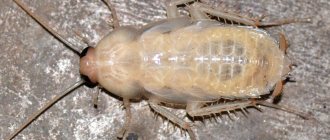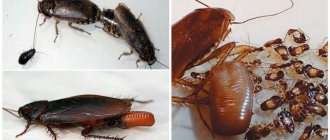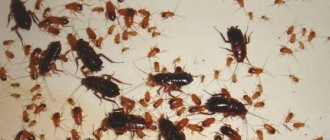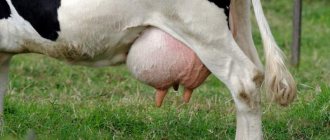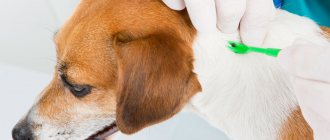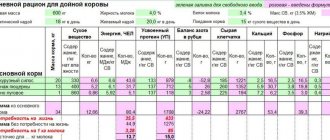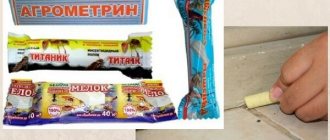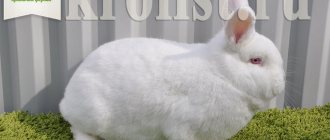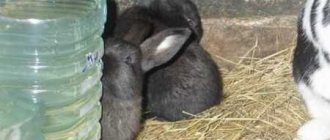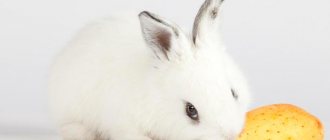Rabbits' intestinal muscles are weak, so they cannot push food through. It is promoted by newly received food, so they eat about 50 times a day. To avoid digestive disorders, you need to properly plan your diet. Therefore, let’s find out how to feed rabbits: what rodents can and cannot eat, and consider an approximate diet for lagomorphs.
How to feed rabbits mash
Mash is an excellent choice for nutrition. Rabbits eat them with pleasure. Sometimes such mixtures are the main ones, especially in small rural farms. This popularity is associated with significant savings. In addition, mixed mixtures perfectly saturate the animal’s body with nutrients.
| The following are often added to mash mixtures: |
| • straw; • carrots, beets, potatoes (peeling them); • onion peel; • cabbage leaf; • melons, their peels (pumpkin, zucchini, watermelon, melons); • crushed legumes, grains; • remains of meat and fish products (chopped, dried); • porridge, noodles; • steamed feed; • grass meal • chopped straw; • meat and bone meal; • table salt, chalk, vitamins. |
The mixture should have a fairly viscous consistency so that it does not spread and does not stick to animal fur. During production, a base is prepared into which the remaining ingredients are mixed. Excellent binding bases are boiled mashed potatoes, pumpkin puree, clover or alfalfa juice.
Approximate ratio of ingredients in rabbit mash
| Mash base (40-60%) |
| • Boiled potatoes and peelings • Steamed beet pulp • Silage, table waste • Boiled vegetable waste |
| Concentrates (30-40%) |
| • Compound feed • Crushed grain (oats, barley, wheat, corn) • Wheat bran • Grass meal |
| Protein and vitamin supplements (5-20%) |
| • Meat and fish meal • Boiled or dry minced fish and meat waste • Whey • Feed yeast |
| Minerals (1-2%) |
| • Bone meal • Chalk • Table salt |
It is convenient to give mash to rabbits in the form of “cutlets”, because they simply do not eat porridge well. Such “cutlets” can be dried in the oven, sprinkled with bran or rolled in sunflower cake, dried nettle or fine hay.
Is it possible to give raw potatoes to rabbits?
As stated above, vegetables are very important for rabbits. Potatoes are a healthy root vegetable, but can you eat them raw? Many breeders ask this question, but do not always receive a clear answer.
Raw potatoes can be harmful to rabbits, especially if given regularly in large quantities. Give it no more than 2 times a week - in very small pieces! Once a week or two you can feed the rabbits and peel the potatoes. But they must be clean and dried.
Important!
You cannot give rabbits boiled potatoes that were made for people, because they are usually salted, peppered, and the mashed potatoes are also seasoned with milk and butter. This is harmful for rodents. The puree for them is made from plain potatoes without additives and even without salt!
But boiled potatoes are not harmful for rabbits. It can be given a little, often in the form of pieces or puree, if we are talking about rabbits. So when you have time and opportunity, it is better to boil the root vegetable - this way it will bring more benefits.
What should you not feed?
It is worth paying special attention to those foods that should not be given to rabbits under any circumstances. When giving green food, consider the list of herbs that should not get into their feeder under any circumstances: datura, henbane, crow's eye, lily of the valley, larkspur, celandine, spurge, foxglove, hemlock, mustard, nightshade, wild radish, marsh horsetail , buttercup
Each of these harmless plants can harm the health of rabbits. Some may cause bloating, for example, a lumbago may even paralyze. Therefore, you need to be very careful and attentive when collecting grass.
And when making hay, you should not mow the grass near roads and industrial enterprises. Rabbits should not be given tomato tops, and should also be fed red beets, grains and legumes in limited quantities. It is forbidden to include onions in the diet, especially for lactating females, as they can make the taste of milk bitter. Rye, millet, millet and polished rice - these products can increase the amount of mucus produced in the stomach due to their solid structure and low fiber content. Under no circumstances should you give grains raw, only after soaking them.
Although potatoes are permitted foods, they should still be given with caution. It is recommended to feed fresh potatoes to animals during the fattening period (due to the high starch content in the tubers)
In other cases, it is better to limit yourself to small portions. You should not give potato sprouts, as they contain a very toxic substance - solanine. It is advisable that rabbits eat only peeled, boiled potatoes. It is also not recommended to feed dairy products, even tiny portions. Give apples only without seeds, because they contain amygdalin, a very harmful substance.
Bread, buns, cookies and other bakery and flour products should never be consumed by rabbits. No sweets, since baked goods contain a large amount of complex carbohydrates, starch, and yeast, which in turn can lead to obesity. The only time when it will be possible to add these products to the diet is during the final fattening period, immediately before slaughter. Prohibited foods also include seeds, nuts, mushrooms, cauliflower, and chocolate. Under no circumstances should you take risks and give cat food.
For information on what to feed rabbits at home, watch the following video.
The benefits and harms of legumes
Whether it is possible to give peas to rabbits and what effect it has on the animal’s body should be found out by studying various sources and adopting the knowledge of experienced rabbit breeders. Peas belong to the legume family and contain a lot of protein, lysine and other useful elements. This product is perfectly absorbed and digested, causing a rapid increase in the weight of the animal. But at the same time, it is not recommended to abuse such legume food, since an excess of peas can cause disruption of the intestines, promoting bloating and the formation of gases.
Small rabbits under one month of age cannot be fed with this product at all, since their body is not yet strong and is not able to digest such roughage. After thirty days from birth, you can try giving them a small amount of peas, observing the behavior of the animals. Rabbits should feel well, lead an active lifestyle and not refuse to eat.
Conditionally permitted and prohibited foods
Rabbits are omnivores, but are sensitive to the quality of the food they eat. Even among the usual vegetables, cereals and herbs, there are some that can negatively affect their health.
A list of conditionally acceptable and unauthorized food for animals is presented below.
Table: permitted and prohibited foods for rabbits
| Name | Innings |
| Oats | Feed in natural or ground form. |
| Corn | Pre-soak in water or crush. Sometimes they cook porridge and mix it with other food. |
| Barley | In crushed or flattened form. |
| Wheat | Mixed with roughage and succulent feed, grass. |
| Compound feed | Sold in the form of granules or in bulk. It is often combined with vitamin and mineral supplements and medications. Complementary feeding leads to rapid weight gain - up to 40 g per day. More suitable for feeding rabbit offspring up to 3 months and animals going to slaughter. Adults are given it in combination with greenfinch and succulent feed mixtures. Always have water available. |
| Pulp, meal | The following cakes are used: soybean, flaxseed, sunflower, beet and hemp. Meal made from flax, sunflower and soybean is suitable. Served steamed or in combination with mixed feed or potatoes. |
| Acorns | They come in pressed briquettes, which are soaked in water in advance. |
| Give with restrictions | Can't give |
|
|
Animals have some peculiarities in terms of digestion. They have a weak stomach, so food must always be present in it. To prevent problems with the digestive system, it is unacceptable to keep rabbits hungry. Over-salted and acidic foods are contraindicated for animals. Freshly cut grass causes bloating, so you don’t give it right away, but let it dry in the sun. It is unacceptable to feed dirty root vegetables.
Contraindications and harm
Feeding oats will be beneficial for rabbits of any age. The main thing is to follow the recommendations and dosages, since such a valuable and healthy grain can cause harm to the animal.
- Animals should not be given green oats cut after flowering, as this can lead to bloating and disruption of the gastrointestinal tract.
- You should also limit the feeding of grain to adults in the productive stage, since excessive feed consumption can cause obesity and, as a result, liver problems.
- You cannot constantly give animals only one type of cereal. To ensure that the nutrition is as complete and balanced as possible, the animals are fed mixtures of grains.
From the point of view of food for rabbits, oats have no contraindications and, with the correct dosage, are not capable of causing significant harm to the health of the animal. When consuming cereal, the main thing is to adhere to the recommended dose, and also take into account the age of the animal and its general condition.
Learn all about feeding rabbits.
How to feed?
Rabbits are animals with an insatiable appetite. If they are healthy and the food is fresh and aromatic, then the animals are ready to chew it all day. In the summer, the problem of nutrition is solved very simply: eared animals can nibble green grass on the lawn, nibble on carrots, and will not refuse vegetable tops.
Types of winter feed
It is better to make provisions for the winter, because, as in the summer, rabbits need adequate nutrition, which includes proteins, fats, carbohydrates, and vitamins. Therefore, the diet of animals should be varied but balanced. “Winter” types of products include:
- hay (makes up 60% of the daily rabbit menu);
- branches of juniper, spruce, aspen and other trees, from which cherries, plums, cherries, and peach should be avoided (due to the presence of hydrocyanic acid, which is poison for fluffies);
- root vegetables (you can plant carrots, potatoes, cabbage with a “spare”, counting on having to feed the eared ones);
- cereals (wheat, barley, millet, corn, etc.); legumes (peas, beans, lentils, alfalfa, etc.).
Animals happily eat special mixtures that are sold in pet stores. The need for salt can be satisfied by purchasing a salt stone and placing it in the cage.
The abundance of dry food in winter requires the animal to receive a sufficient amount of water. If it is dirty and does not change for several days, the rabbits will not drink it, the instinct of cleanliness is too strong in them. Therefore, water should always be fresh, in sufficient quantity, and feeders should be cleaned daily of food debris.
Feeding rules
The number of feedings depends on many factors: on the availability of free time for breeders, on the characteristics of the animal’s breed, on their rapid or slow growth, and on age. Recommendations for the feeding process are as follows:
- Rabbits should receive their next meal at the same time.
- It is necessary to ensure that the dry grass in the feeders is always fresh.
- The minimum number of feedings is 2 (in the morning and evening, when the rabbits have a “brutal” appetite), and the optimal number is 5-6, which is very rarely achieved by breeders due to their daily busyness with other things.
- Dampness and dirt should not be allowed into the “home” of the little ears, because from such conditions they quickly get sick and die, as they say, “in batches” - both adults and children. The rabbit is sick - there is no appetite, weight is lost, and the immune system weakens. The animal dies very quickly.
- The room, which will “predispose” animals to prolong their offspring and the desire to chew something, should be well ventilated, but not subject to drafts; sufficiently illuminated, but at the same time so that the long-eared ones have the opportunity to hide in a shaded corner.
- The water must not be allowed to freeze. If rabbits are thirsty, they will chew on ice. And this can negatively affect their health. Ice must be removed from the cage promptly.
- If both food and food are in a warm state, the animal’s body will not have to waste energy on warming them, so the digestion process will occur faster, and accordingly, appetite will arise more often.
- When animals begin to be fattened before slaughter, it is better to seat them one at a time.
- You should not overuse legumes and beets. The former causes flatulence in animals, and the latter causes a weakening of the intestines.
- Potatoes are much better digestible if given boiled.
- The transition from summer to winter nutrition occurs gradually. You can’t just start feeding your rabbits hay and grain all at once.
- Portions of greens decrease day by day, then they begin to be excluded from some meals altogether.
If these points are taken into account, rabbits will eat well in winter and produce strong and healthy offspring.
In what form can grain be given?
The benefits of feeding rabbits concentrated food are obvious. But it is not recommended to make it the only option for the animal menu, since the diet must necessarily include succulent feed and hay. This will eliminate the likelihood of developing vitamin deficiency in lagomorphs. In order for rabbits to have a complete diet, cereals should be prepared in advance, which will increase their nutritional value and benefits. Processing cereal crops will improve their digestibility and have a beneficial effect on metabolic processes in the body.
Some breeders feed rabbits with grain as usual, without using crushing. This approach will be irrational in terms of feed grain consumption, since dry grain will have lower nutritional value for animals.
There are several secrets to preparing cereals for lagomorphs:
- corn and barley are better and faster absorbed in the body if they are steamed or crushed before serving;
- oats and wheat can be left in their original form, since they will be chewable for rabbits;
- to increase the vitamin value of crops, sprouted cereals are used for feeding;
- It is better to mix corn with legumes, for example, peas or succulent feed;
- purchased feed should be stored in a room with low humidity to avoid the development of fungus and mold;
- You should crush grains with your own hands in proportions that will be enough to feed for several days, so that the grain does not go rancid ahead of time.
It is worth noting the basic methods of preparing grain for rabbits.
Yeasting
Most often used when raising meat breeds, with the goal of quickly gaining weight in animals. Feeding grain prepared by yeast is allowed for individuals older than four months. The essence of the method is to combine ground cereal with water in a proportion of ½, after which 36 grams of yeast are diluted in 2 liters of water.
All ingredients are combined, mixed thoroughly and left for 9-12 hours in a closed container.
Steaming cereals
This method improves the organoleptic qualities of the grain; in addition, food in this form is much easier to digest. To prepare grain for animals, choose one grain or a mixture of crops, pour them into a deep container, then pour boiling water over them and add a spoonful of salt. Leave in this form under a closed lid for 5-7 hours.
Germination
Every rabbit breeder should know that sprouted grains can greatly enrich the animal’s body with important microelements and vitamins. If you germinate a crop, then even more vital components will naturally be released from it, which will be completely absorbed by the individual’s body. Fiber, contained in many cereals, in sprouted form will act as an absorbent that cleanses the intestines of rabbits well.
To properly germinate cereal, you should choose good grains, place them in a plate with water or a damp rag, maintaining moisture. In such an environment, the culture will begin to germinate quite quickly. For large household plots, grain is sprouted in bags, after soaking oats or other crops in a bucket of water. With the first appearance of sprouts, the fortified food for rabbits will be ready.
Use of vitamin and mineral supplements
Vitamin preparations are usually administered in late winter, when there are not enough natural vitamins in the feed. They can be bought at a veterinary pharmacy; the range of products is quite wide, for example, the following are popular:
- Chiktonik;
- E-Selenium;
- Prodevit et al.
Depending on the method of administration, drugs are administered by injection, vitamins are added to water or simply to food.
They give their pets fish oil, as well as oil solutions of tocopherols and calciferols, and retinol. To replenish the body of rabbits with vitamins, especially compounds from group B, they are given baker's and brewer's yeast; to replenish vitamins and animal protein - fish meal and meat and bone meal (5-10 g per individual). Tricalcium phosphate is also used, from which rabbits obtain calcium and phosphorus.
Fish oil is given to rabbits in the following volumes (per individual):
- rabbits - 0.3-0.5 g;
- for adult livestock – 1 g;
- for female rabbits during pregnancy and feeding – 3 g.
Regular salt is given in a volume of 0.5-1 g per 1 head (young animals) and 1-1.5 g per 1 adult.
Norms and feeding regimes
Adult rabbits need to be fed at least 2 times, and even better 3 times a day. But the younger the livestock, the more often they should receive food. The maximum number of feedings is 4 times a day; more often only weanlings are given food. It’s easier to feed rabbits not by hand, but to put up special bunker feeders and hay barns, pour food into them, and the animals themselves will take from them how much and when they need it.
Rabbits can eat often, almost constantly, but better results can be achieved if they are fed according to a schedule. For example, experienced rabbit breeders use such schemes.
| Winter 3 times feeding: | Winter 4 times feeding: |
| 8 hours – half the daily volume of concentrates and hay; 12 hours – succulent food; 17:00 – second half of hay, branches and grain. | 6 hours – a third of grain and a quarter of hay; 11 hours – a third of concentrates and half of juicy ones; 16 hours - half of the hay, vegetables and root vegetables; 19 hours - a third of grain and a quarter of hay + branches. |
| Summer 3 times feeding: | Summer 4 times feeding: |
| 6 hours – half concentrates and a third herbs; 15 hours – a third of the volume of greens; 19 hours – half concentrates, one third greens + branches. | 6 hours – a third of concentrates and 1/6 of greens; 11 o'clock - the same; 16 hours – half the norm of grass; 19 hours – a third of concentrates, 1/6 herbs + branches. |
During the rest period
At about 1 month, babies begin to feed on their own. At this time, they are gradually transferred to the food that the rest of the livestock eats. Month-old rabbits are fed fresh but dried grass, crushed grain, bran, grated vegetables, potatoes, and root vegetables.
As the young animals grow, the norms for all feeds increase. Animals destined for meat are housed separately and fed according to a special scheme. Salt and chalk are given to all rabbits, starting from 5-7 months, the same - 1-1.5 g all year round. Until this age, the norm is 2 times less.
During the period of preparation for mating
Breeding animals are also fed grass, tops, weeds, grain mixtures in summer and winter, root vegetables, kitchen waste, fruits and vegetables. Nutrition during this period (2-4 weeks before mating) should be organized so that the rabbits are moderately well-fed, but not obese.
The food must certainly contain complete proteins and minerals, so legumes, grains and grass, fish meal and meat and bone meal are certainly included in the menu of future parents.
Baby rabbits
Pregnant females need an increased amount of nutrients for the development of their rabbits, especially in the last third of pregnancy. Their food should contain easily digestible and good-quality food, the share of which is increased by 20% compared to the menu of the rest of the livestock.
During the period of suction
The need of the female feeding the offspring for nutrients increases even more, therefore, the older the rabbits become, the more food she should be given. 2 days before and after birth, the animal is fed hay and given water, then transferred to a regular diet.
It must contain succulent food, grass with a high content of protein and minerals, dairy products, potatoes, vegetables, fruits, dill, and a lot of water. A rabbit weighing 3-5 kg requires 19.5-32.5 g of protein and 90-150 starch units. Rabbits that are with the female will try the same things that she eats, so there is no need to specially feed them with anything.
The difference between factory feed and natural feed
Every livestock breeder should know what to feed a decorative rabbit. In stores, consumers are offered a large selection of different feeds. They are rich in vitamins, microelements, and acids. But if you feed animals exclusively with commercial food, they will quickly begin to gain weight. Therefore, it is often prohibited to give this type of food. With daily consumption of dry food, the pet will begin to refuse natural food. And this type of nutrition must be present in the diet. Therefore, purchased food should be given in limited quantities. Experienced livestock breeders recommend giving them to animals as a reward or treat. It should be noted that eared animals are herbivores. Mixtures of dry fruits, grains, and nuts are undesirable for them. Properly selected high-quality feed contains 20% unrefined fiber, 1% calcium and fat, 15% protein.
What not to give to decorative rabbits
All rabbits are herbivores, but some owners are too keen on experiments and include unnecessary, harmful foods in their pet’s menu.
Even plant foods are carefully selected; the stomach of a small animal will not always digest the volume of fiber or hard seeds.
Not allowed for use:
- milk, cottage cheese, butter, kefir and other dairy products (rabbits do not need animal protein even in small quantities);
- meat, poultry, fish;
- young or green potatoes, eggplants, red cabbage, radishes, onions, tomatoes, cucumbers, beets;
- citrus and exotic fruits (grapefruits, mangoes, papaya, oranges, pineapples, avocados and others; apples and pears are best);
- rice, rye, millet, millet;
- legumes (except dry yellow peas);
- unfamiliar and poisonous herbs: dope, lily of the valley, hemlock, spurge, buttercup, larkspur, hellebore, foxglove, crow's eye, henbane, poisonous weed, celandine, nightshade, lumbago, poppy;
- sugar, chocolate, baked goods (cakes, bread, crackers, ice cream, chips).
For furry babies, plants that are mowed near the road, factory, or near the supermarket building will be dangerous. The collected food is thoroughly washed and dried. For treats, it is better to use ready-made ones, which are sold in pet stores.
Nutrition of decorative breeds
If rabbits are bred not for meat, but for beauty, the feeding process changes somewhat. The diet itself remains approximately the same. It should also include fresh and dried grass, various gifts from vegetable gardens and orchards, animal feed, mineral and vitamin supplements. But you can’t just build a bunker feeder for your pet. He will become fat and will not live long.
Decorative rabbits require a special approach
It is important to maintain a balance between constant chewing and daily nutrient requirements, as well as to control your pet’s body weight. To ensure a natural feeding regime, it is worth purchasing feeder toys for your fluffy, which make it difficult for the animal to access food and force the animal to get it:
To ensure a natural feeding regime, it is worth purchasing feeder toys for your fluffy, which make it difficult for the animal to access food and force the animal to get it:
- balls made of metal wire for grass and pieces of vegetables (hanging and rolling on the floor);
- plastic balls for granulated food;
- “hedgehogs” made from twigs.
The advantage of such feeders is that the rabbit will be busy most of the day, and he will not have time for mischief.
Feeding rabbits in winter
Feeding rabbits in winter is aimed at increasing nutritional value, while the amount of roughage and concentrates eaten increases. During the winter cold they need energy.
It is also necessary to adhere to such subtleties of winter feeding of rodents:
- Providing rabbits with constant access to food (especially at night and in the morning). A bunker feeder can help with this, as it will prevent over-consumption of feed.
- There should be clean water in drinking bowls, as this is important for young animals and females. In winter, the water can be heated.
- Feed rabbits food containing fiber, which will have a beneficial effect on the function of the digestive tract.
- When feeding several foods at the same time, concentrates are given first and juicy foods second. Feeding rabbits in winter is completed with the distribution of hay.
Figure 8. Diet for rabbits in winter
Figure 8 shows an example of a winter diet for rabbits. It is not recommended to give food containing carbohydrates - cookies, sugar and other treats. Eating this type of food can cause obesity.
Since dispensing feed and drinking water requires the use of special equipment, we recommend that you watch a video about making a drinking bowl for rabbits with your own hands.
Diet structure and feeding norms
The daily feeding ration for rabbits should include nutrients that can meet the needs of the animals. The greatest need for nutritious feed is experienced by lactating rabbits and young animals, and rabbits need such feed least of all during physiological rest (Figure 9).
You can feed rabbits grass and hay in unlimited quantities, which will not harm the health of the animals. However, the amount of other foods in the diet should correspond to modern scientific feeding standards. It is not recommended to allow a lack or excess of nutrients.
Profitability of raising rabbits for meat
First you need to determine for what purpose you are getting rabbits. If you are just starting to breed them, then it is more profitable to take well-known local breeds.
The profitability of raising rabbits is determined by several factors (Figure 6):
You need to purchase healthy, active individuals, with a well-fed, well-built body, clean eyes and shiny fur. Animals with elongated heads, floppy ears, sagging backs and bellies, and balding hair are considered unsuitable. You need to take care of the housing for the livestock in advance. For outdoor keeping, cages with two compartments are equipped. Feeders and drinkers are fixed inside. Indoors in winter, cages with double ceilings and thick walls are insulated. Cages can be made of different materials, but there should be no drafts in them
It is important to ensure a constant flow of fresh air and optimal daylight. The cells are arranged in several tiers with a passage between them and moderate lighting. When raising rabbits for meat, the light intensity is reduced for the fattening period.
Then choose a maintenance method that will suit your conditions. If there is not enough space on the site, but there is a basement or cellar, then you can keep animals using the pit method.
Rabbit meat is a quickly digestible, high-quality product containing a lot of protein. It is recommended for children, athletes, women during pregnancy and lactation.
Figure 6. Calculation of the profitability of rabbit breeding
When raising rabbits for meat, profit will be brought by meat breeds with rapid growth, weight gain, good quality products, as well as representatives of the meat-skin direction of productivity.
All carcasses must comply with approved GOSTs and quality standards. After slaughter, carcasses are cleaned of all internal organs except kidneys. The head is separated at the first cervical vertebra, the hind limbs at the hock joint, and the forelimbs at the carpal joint (Figure 7).
Rabbit carcasses are usually divided as follows:
- Cooled - temperature no more than 25 degrees;
- Chilled - from 0 to 4 degrees;
- Ice cream - no more than 8 degrees below zero.
To sell rabbit meat, it must be frozen or refrigerated. It is not allowed to sell carcasses to retail chains if they have the following defects:
- Bone fractures;
- Back fat takes up more than a third of the total length of the carcass;
- Cleaning up bruises or bruises;
- Carcasses that were frozen more than once, after which the color changed (became flesh-colored).
During marking, each carcass is marked with a mark on the outer side of the drumstick: carcasses of the first category are given a round mark, carcasses of the second category are given a square mark, and broiler carcasses have an oval mark. If the carcass does not meet the requirements, a triangular mark is placed on the back. From the video you will learn basic recommendations for fattening rabbits for further sale for meat.
Business plan "rabbit farm"
To benefit from rabbit breeding, a business plan is drawn up that considers the main aspects of rabbit farming. A farmer needs to become an individual entrepreneur, since this form of ownership reduces taxes and makes accounting easier.
Figure 7. Cutting a rabbit carcass
The profitability of raising rabbits for meat is average, since this product is not considered the most popular on the market. Fattening animals for meat as a business includes several preparatory stages.
First of all, you need to select a plot of land. A profitable option would be a plot with a minimum rent. The next step is purchasing cells. By building them yourself, you can save your money. At the third stage, you should purchase rabbits. And also hire an employee who will take care of the animals.
The organization of sales must be thought out before starting the organization of the economy. Clients can be meat markets, supermarkets, and individuals. The skins can be sold to fur studios and private fashion designers.
What you need for rapid growth and weight gain
Rapid muscle growth requires energy, protein and vitamins. Most of these substances are found in the following plant products:
- bean hay;
- grain of corn, barley, peas, wheat;
- sunflower cake.
Vitamins are required to absorb nutrients. The record holder for the content of nutrients a rabbit needs is carrots.
On small home farms, boiled potatoes mixed with wheat bran are successfully used for the final stage of fattening rabbits for meat.
Fast Animal Growth
Active growth of young animals is ensured by fortified feed. The rabbits' diet includes bean hay, cut during the budding and flowering phase, carrots, apples, and a grain mixture of barley, corn and wheat. Buckwheat is considered a healthy grain that strengthens the body. It is given in dry form as part of grain mixtures.
Fast weight gain
Fattening rabbits should be given up to 40% of the daily diet of concentrates. Instead of crushed grain, you can feed animals with cereals - they are more fully digestible. Nutritious cereals: corn, pearl barley, peas, eggs, wheat.
Vegetables can be excluded by replacing them with potatoes, acorns, and cake.
What food to choose for rabbits
In fact, feeding baby rabbits at home is not a difficult task for beginners. The animals presented are unpretentious, although they get sick very often. With a properly designed diet, this negative factor can be eliminated. Choose food for animals based on the current time of year.
In warm weather, the best option for feeding is green food:
- fresh grass, wild growing;
- young woody shoots;
- fresh green leaves.
This food is beneficial for the rabbits’ body, in addition, feeding becomes less expensive
When choosing grass for your diet, you should pay attention to wild varieties. This could be clover and wormwood, yarrow or nettle.
You can also add fireweed, shepherd's purse or plantain to your diet. Rabbits will not refuse horse sorrel and burdock. You can easily collect these herbs yourself without spending money on food.
Why is proper diet so important for rabbits?
A balanced diet allows you to achieve a rapid increase in live weight at the lowest cost of feed and money.
A well-fed and healthy female rabbit bears and feeds more than 30 rabbits in a year. With optimal nutrition, the slaughter weight of young animals of 3.5–4.5 kg is achieved in 120–150 days.
Proper nutrition will allow the females to cover 3-5 days after the birth of the rabbits.
What do rabbits eat at home: vitamins, minerals
It is extremely important for these animals to receive sufficient amounts of vitamins, especially during cold periods. Fish oil is very important for them, which is dosed as follows:
- for babies - 0.5 g per individual;
- for an adult animal - 1.5 g;
- for pregnant and lactating females - 3 g.
Culinary yeast and hay are rich in vitamin E, and it is also found in sprouted grains. And from ordinary chalk, an animal can get a sufficient amount of calcium.
Table salt is very important for animals, which must be given to them in the following ratio:
- babies - 0.5-1 g;
- adults - 1.5 g;
- lactating females - 3 gr.
Cereals
Cereal crops are a group of cultivated plants, the ripening of which produces grain, as well as raw materials for animal feed. Cereals such as wheat, oats, barley, corn belong to the cereal grain crops. This type of grain crop is grown on many continents of our planet. One of the main purposes is pet food.
For rabbits, grain nutrition has become the basic diet. This feeding method is quite popular among owners. Grain is the best food suitable for rabbits. It is especially useful in winter. Suitable cereal crops include: barley, wheat, oats, corn, etc. The positive properties of grain are: nutritional value, easy digestibility, optimal ratio of BJU.
Selection of roughage
It has already been said above that the rabbit’s diet must be varied. One feeding option is roughage. In this case, various herbs, dried straw, and thin tree branches are suitable. One of the best candidates for this type of food would be hay, because it contains a large amount of fiber, which significantly improves digestion in rabbits. Making hay is quite simple; to do this, you need to mow the grass (manually or using special equipment), preferably in a meadow where a huge number of all kinds of useful plants grow - clover, chamomile, alfalfa, peas. When collecting grass, you should mow it before flowering and carefully ensure that you do not come across plants that are poisonous to rabbits (celandine, dope, wild mustard). After everything is mowed, the harvested crop is quite simply dried in the sun, collected into sheaves and food supplies are ready.
Hay harvesting should be done at the rate of approximately 45 kg of hay per adult for wintering. It is better to store hay under a canopy, providing good ventilation, but at the same time so that it does not get wet or collect moisture. In addition, it is worth noting that hay is a fairly nutritious product, which is an important aspect when fattening rabbits. It is best to give it in late autumn and winter, when supplies of fresh grass have dried up, as well as in early spring - before fresh greenery appears. Sometimes pea or oat straw can be given instead of hay, as it contains a lot of fiber. However, rabbits do not eat it very well, and it is also poorly digestible. Therefore, it is better to give it only to adults and only on the condition that other types of food are already running out.
When you haven’t had time to prepare hay or your supplies are insufficient, another good option comes to the rescue - this is branch feed. It is considered an essential component in the diet of rabbits, and is also a fairly affordable and healthy type of food. By the way, soft twigs help rabbits grind down their teeth and avoid gnawing through the cage. To do this, you can prepare twigs from trees such as birch, linden, willow, willow, aspen, maple, poplar, ash, apple, pear, acacia, oak, alder. Branches of coniferous trees - spruce, pine, cedar - are in particular demand.
However, not all trees are worth plucking branches from. You should not give rabbits shoots of apricot trees, bird cherry, buckthorn, elderberry, wild rosemary, cherries, plums, cherries, and peach. These representatives contain toxic substances (for example, hydrocyanic acid), which can adversely affect the health of your long-eared pets. Preparation of branches should be done at the beginning of summer, cutting them off and collecting them in brooms, and also dry them thoroughly and store them in a ventilated place. In winter, if the supply of “summer” twigs runs out, spruce twigs will be an excellent option, which rabbits will eat with great pleasure. In addition, by eating branches of coniferous trees, animals' digestion improves, their fur takes on a beautiful, well-groomed appearance, becoming smoother and shiny. This type of food is universal, as rabbits can eat it all year round.
Is it okay to give leaves and branches to rabbits?
Also check out these articles
- The best grape varieties Muscat
- Growing watermelons in open ground
- White-fronted goose
- Rose Victoria - a climbing garden decoration
Pagons of bushes and trees also belong to roughage, so giving them is necessary and useful. Eared animals are very fond of branches of bushes and trees (especially fruit trees). It is recommended to give rabbits twigs: raspberry, acacia, rowan, aspen, willow, maple, linden, willow, poplar, hazel, apple, oak, alder.
In addition to useful twigs for rabbits, there are also prohibited ones. Therefore, before giving a rabbit a branch of a tree or bush, you need to figure out what can and cannot be given to rabbits. So, the following branches are considered the most dangerous:
- apricot (and any stone fruit trees);
- wolfberry;
- bird cherry;
- elderberries;
- wild rosemary;
- buckthorn.
Along with the twigs, the leaves that were on the pagon are usually fed, but the leaves are usually not easily torn for feeding. You can give leaves only a couple of times a week, not more often.
